Menus
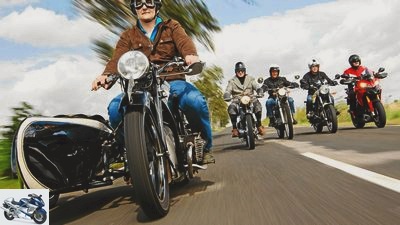
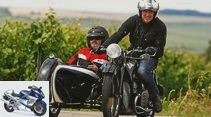
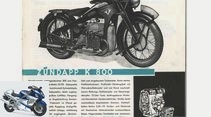
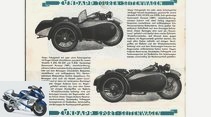
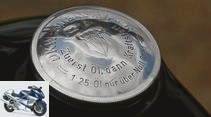
20th photos
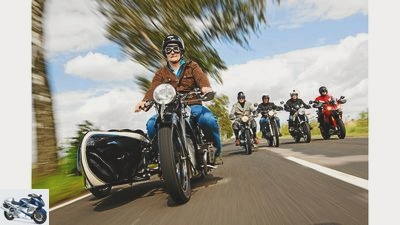
1/20
Zundapp K 800 sidecar, DKW RT 175, Honda XL 250 Motorsport, BMW R 100 R Mystic and Ducati Multistrada 1200 S in a generation comparison.
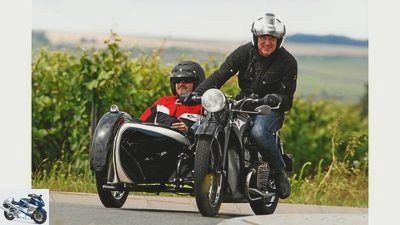
2/20
Zundapp K 800 team.
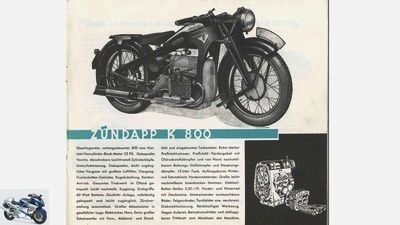
3/20
Original Zundapp brochure from the 1930s. As you can see, the sidecar was available from the factory.
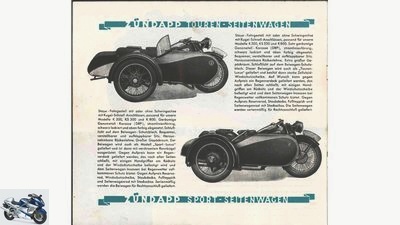
4/20
Original Zundapp brochure from the 1930s. As you can see, the sidecar was available from the factory.
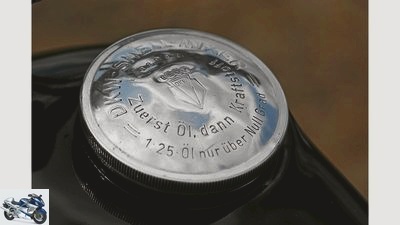
5/20
There is really something to read on the tank cap at DKW.

6/20
The battery box of the RT can be opened with the half-disk on the ignition key.
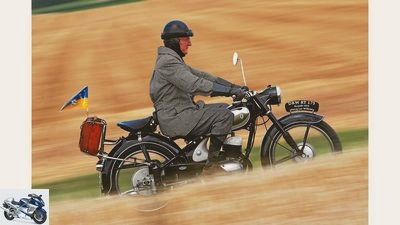
7/20
DKW RT 175: The area under the driver’s saddle is fully encapsulated on the RT – the designer Kuchen also worked for DKW.

8/20
Original brochure from DKW.
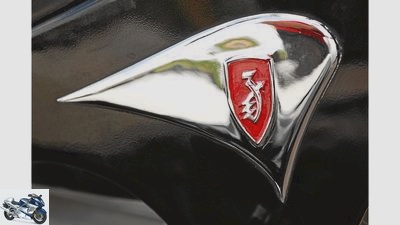
9/20
The Gothic “Z” and the flash stand for “Zunder-Apparatebau-Gesellschaft”.

10/20
The steering damper is vital for sidecar use.
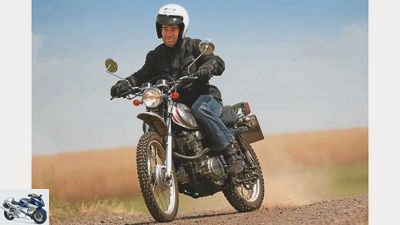
11/20
Honda XL 250 Motorsport: Motorsport headlights, indicators and taillights can be easily removed for serious terrain.
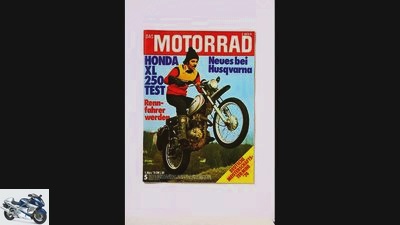
12/20
Original cover from 1974.
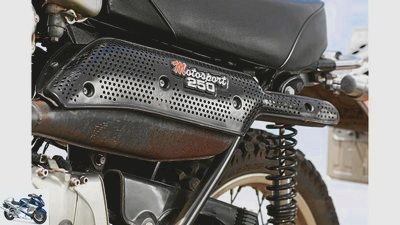
13/20
At the beginning of the 70s the owner’s dream motorcycle, acquired in the USA in 2005 via Ebay: Honda XL 250 Motorsport.
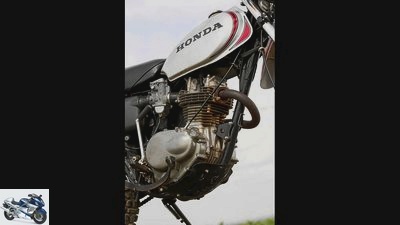
14/20
Engine of the Honda XL 250 Motorsport.
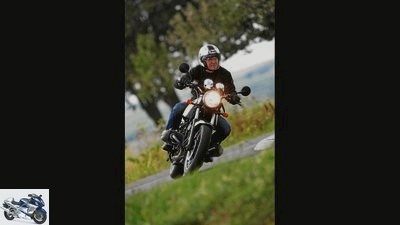
15/20
BMW R 100 R Mystic.
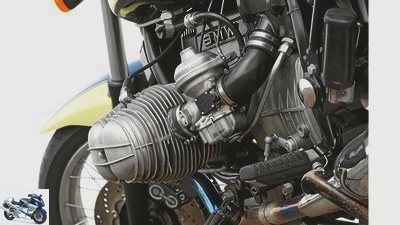
16/20
At the end of its era, the two-valve boxer got round valve covers again.
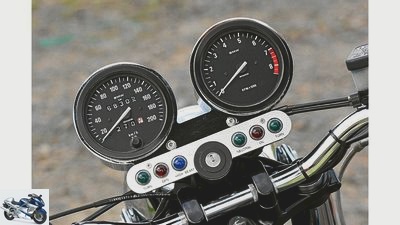
17/20
The cockpit is a specialty of the Mystic special model.
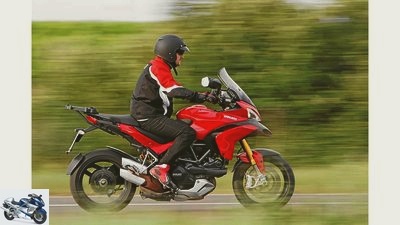
18/20
Ducati Multistrada 1200 S..
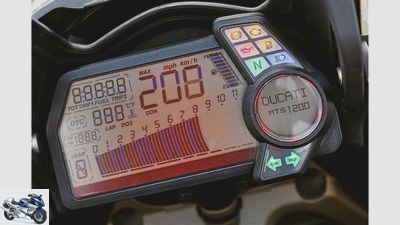
19/20
The Ducati is an electronic surprise bag in every respect. Most likely to be visible when the cockpit displays find themselves.

20/20
75 years of development, shown in five motorcycles.
Five-generation motorcycle comparison
Anniversary: One test machine from every 500th edition
The MOTORRAD editorial team selected a test machine from every 500th issue, took a trip with the five machines and now knows what it feels like to switch from one to the next and enter another time.
D.he 500th edition of “Das Motorrad” was issue 10/1935. Unfortunately, it does not contain a driving report and neither a test, nor a “test”, as was the usage in the Third Reich, which even tried to avoid the anglicism “test”, which is hardly recognizable as such today. So turn the pages. In issue 13/1935 an Imperia 350 “Wehrsport” appears. At that time, many motorcycle manufacturers put together prototypes with the help of which they vied for orders from the Wehrmacht. Author Helmut Werner Bonsch served the manufacturer with a kind of expert opinion on the machine and ensured publicity. In return, “Das Motorrad” received a story. The deal must have gone roughly that way back then – the author uses this Anglicism here with great pleasure. The Imperia quickly disappeared, however.
Issue 15/1935, the Easter edition: “Das Motorrad” tests the Zundapp K 800. Well, please, let’s take this unusual four-cylinder boxer machine from issue 505. But actually finding one today was not so easy. Dozens of K 800 owners will probably answer this article and wonder why they didn’t ask them straight away, but it took weeks and until the last possible date to find someone who owns such a motorcycle in running order, even with the original sidecar. After careful consideration, he was ready to let the MOTORRAD editor ride it. The daring man is called Wolfgang Vollmer.
A similar problem arose with the 1000th issue, issue 25/1954: no motorcycle in the test. Two issues earlier, however, good news appeared on the cover: “Test (!) DKW RT 175”. With which the second candidate was destined for the exit and was quickly found through the mediation of the Balingen specialist for old DKW, Bernhard Greiner. Georg Wilkens willingly made his 1954 RT available to us.
The Honda XL 250 Motorsport made a precision landing. On the one hand, the enduro with the first four-valve engine from mass production was tested in the 1500th edition, issue 5/1974, on the other hand, a beautiful example of this rare type was found in the possession of Rudolf Probst, the press spokesman for BMW Motorrad. He lent it generously, knowing that it would also help a BMW into the magazine. In the 2000th issue of MOTORRAD, issue 11/1993, a driving report of the R 100 R Mystic was published, and this special model with a classic two-valve boxer was also chosen for the longitudinal section through motorcycle history. At the BMW meeting in Garmisch, Jurgen Beck and his 1995 Mystic fell into the hands of the MOTORRAD recruiters, so a valuable specimen from a last series of 300 motorcycles with a mustard yellow and black two-tone paint scheme, a special model, so to speak, joined the group.
Subscribe to MOTORRAD videos on Youtube
From the pool of machines currently running in the MOTORRAD endurance test, the Ducati Multistrada 1200 S was recommended. With state-of-the-art electronics, enormous performance and consistent lightweight construction, it embodies the current technology trends almost perfectly.
But the past is more interesting at first. The H-shift lever on the Zundapp’s gearbox alone ensures excitement for the MOTORRAD editor, not to mention the shift pattern. Right behind is the first gear, the second on the right in front, the third on the left behind, and the fourth on the left in front. The driver must feel the knob of the shift lever between the frame profile and the splayed knee before shifting. The gear changes are usually accompanied by distinctive noises, even with the experienced owner of the three-wheeled antique. That comforts the layman. Fortunately, the silky smooth, side-controlled four-cylinder boxer from the Zundapp does not require a lot of manual work.
75 years of development, shown in five motorcycles.
Vibrations only appeared with the increasing combustion pressures of high-performance engines; This flatterer teaches that very impressively about an engine. On the other hand, 22 HP does not uproot trees, not even if they are freshly planted. The four cylinders are supplied with mixture by a lonely 22-inch carburettor through winding channels, a disaster in terms of flow. In addition, designer Richard Kuchen did not pay much attention to the cooling of his motors. He accepted that the rear cylinders of the wind-cooled engine had to endure a real scorching heat in warm weather. In addition, he has neatly encapsulated the entire periphery for aesthetic reasons – carburettor, alternator, ignition coil, distributor. This created a tidy block of heat between the cylinder blocks. After stopping, you should either continue driving straight away before the build-up of heat leads to the formation of vapor bubbles in the carburetor and soften the copper paint on the ignition coil windings, or wait until the built-in climatic disaster has normalized.
In terms of brakes and chassis, the fall back into the past could hardly be more drastic. In addition, there is the completely normal driving dynamics madness that cheers motorcycle teams anyway.
For fear of straying from the straight road, it took the MOTORRAD editor a long time to overcome at a breathtaking 55 km / h before he took his right hand off the handlebars to shift into fourth gear – and walked a long way before intersections and roundabouts left for downshifting and braking.
Please don’t get me wrong, driving the K 800 is unbridled fun. Just let nobody have any illusions about it. You chug through the area at a mock pace and still have your hands and feet full, hear, feel and sniff everything that the motorcycle is doing. And after a few kilometers you have the feeling that you have really achieved something physically.
Less pronounced, but it also happens in a similar form on the DKW. At least the gears can be changed with light swabs on the gear lever, even easier than on many modern motorcycles. That is a good thing, because with 9.5 PS you have to shift down on every sustained incline or in a headwind. 90 km / h on the speedometer corresponds almost exactly to the top speed, and the DKW driver likes to keep his hands on the handlebars because the RT develops its own ideas on the subject of line selection.
Subscribe to MOTORRAD videos on Youtube
In the test report from 1954, the author Heinz Hahmeyer mainly dealt with the adjustable saddle suspension in the section on the chassis, which he attributed to a great influence on comfort and driving stability. The saddle suspension was adjusted to the owner Georg Wilkens featherweight and went to block with the MOTORRAD driver while standing. They should have been set correctly …
By today’s standards, nobody would describe the half-hub front brake of the Honda XL 250 Motorsport as very good, but compared to the Zundapp and the DKW it is a revelation. The oldies are designed for smooth driving, and that not only affects the brakes, but also the engine characteristics. Large centrifugal masses allow both the four-cylinder four-stroke boxer and the single-cylinder two-stroke engine to rev up slowly and keep the respective engine speed for a relatively long time. Almost like stationary engines, they always seem to run at one speed level and are brought to different speeds by the gear ratios.
Zundapp K 800 sidecar, DKW RT 175, Honda XL 250 Motorsport, BMW R 100 R Mystic and Ducati Multistrada 1200 S in a generation comparison.
The dynamics of motorcycling that we are used to, the rapid revving of the engines, only brought the Honda from 1973 (an import from the USA and therefore older than the “German” XL) into the group of time travel machines. That may be with an output of 20 SAE -PS and the already mentioned half-hub brakes sound strange.
The nimble sweeper is actually much faster and slower than his ancestors. Anyone who treats the four-valve single-cylinder carefully during the warm-up phase and upshifts early does not yet recognize their temperament. But between 5000 / min and 8000 / min, where the red area begins, it really blooms. However, it vibrates strongly with increasing speed; When driving overland, the question is what level of vibration you and the motorcycle would like to expect over the long term.
The undercarriage of the small XL, with Wilbers springs in the fork, improved on target, also shows that the modern age began between 1954 and the early 1970s. Because bumps and the reactions of the suspension to them really have something to do with each other. Despite the appealing parallelogram fork of the K 800, this is only partially the case with the older machines. It bounces because of the sidecar, because of twisting and friction at the front and back somehow. And be it, as with the Zundapp with its rigid frame, only the rear tire.
The BMW R 100 R Mystic was already addressed as a neo-classic when it appeared in 1993. That’s true; it is one of the last motorcycles in a line of development that began with the BMW R 75/5 from 1969. Nevertheless, the chassis of the Mystic looks modern. Although the fork is a bit bumpy, the front and rear suspension works comfortably and is still sufficiently tightly damped. On the new Bridgestone BT 45, handiness and accuracy are a poem, and the double disc brake at the front proves to be snappy.
The good old two-valve boxer unfolds a charm that is difficult to describe. Its steady, robust exhaust sound, the valve ticking, the change between smooth running and vibrations when going through the speed range and a remarkable temperament work together harmoniously. On the other hand, the self-adjusting adjustment screws for the idle air mixture or the starting behavior of the boxer, which sometimes degenerates into an organ when it is half-warm, relentlessly demonstrate the limits of carburetor technology.
At this point the Ducati Multistrada demonstrates what contemporary electronics can do. If it is difficult to start, this is at most because the battery voltage is too low, because the mixture preparation itself is always perfect, no matter how cold or halfway the engine may be. Even compared to the second youngest machine, the chassis works precisely like a scalpel, the brakes, precisely controlled by the ABS, work mercilessly efficiently when the lever is pulled hard, and their almost 150 hp can develop in a way that our motorcycle-riding grandfathers probably did Ride on a cannonball would have occurred. But it would also be very gentle and controllable. However, neither K 800 driver Vollmer nor RT 175 owner Wilkens, who both accompanied the trip, wanted to be convinced of this. They declined the offer of a test drive with thanks, they would rather stay in their world.
Yet it is the same world, only recorded at a different point in time. And from time to time it is inseparable from today.
Zundapp K 800 team.
Zundapp K 800
Data
Four-cylinder boxer engine, side-controlled, 791 cm³, 22 HP at 4000 rpm, double-loop sheet metal press frame, four-speed chain transmission, cardan drive, parallelogram fork, rigid axle at the rear, simplex drum brakes at the front and rear, tank capacity twelve liters, weight with a full tank approx. 199 kg (without Sidecar). Price 1935: k. A..
DKW RT 175: The area under the driver’s saddle is fully encapsulated on the RT – the designer Kuchen also worked for DKW.
DKW RT 175
Data
Single-cylinder two-stroke engine, 174 cm³, 9.5 PS at 5000 / min, 13.7 Nm at 3600 / min, double-loop tubular steel frame, four-speed gearbox, chain drive, telescopic fork, straight-line suspension, simplex drum brake at the front, Ø 150 mm, half-hub drum brake at the rear , Ø 150 mm, tank capacity 13 liters, weight with a full tank 117 kg. Price 1954: 1475 DM.
Honda XL 250 Motorsport: Motorsport headlights, indicators and taillights can be easily removed for serious terrain.
Honda XL 250 Motorsport
Data
Single-cylinder engine, 248 cm³, 20 SAE-PS at 8000 / min, 19 Nm at 6500 / min, single-loop tubular steel frame, five-speed gearbox, chain drive, telescopic fork, suspension struts, half-hub drum brakes front and rear, Ø 120 mm, tank capacity twelve liters, full weight 135 kg, price in 1974: 3538 DM.
BMW R 100 R Mystic.
BMW R 100 R Mystic
Data
Two-cylinder boxer engine, 980 cm³, 44 kW (60 PS) at 6500 / min, 76 Nm at 3750 / min, double-loop tubular steel frame, five-speed gearbox, cardan drive, telescopic fork, spring strut, double disc brake at the front, Ø 285 mm, drum brake at the rear, Ø 200 mm , Tank capacity 24 liters, weight with a full tank 228 kg, price 1993: 17,950 DM.
Ducati Multistrada 1200 S..
Ducati Multistrada 1200 S.
Data
Two-cylinder V-engine, displacement 1198 cm³, 109 kW (148 PS) at 9250 / min, 134 Nm at 8000 / min, steel space frame, six-speed gearbox, chain drive, upside-down fork, strut, double disc brake at the front, Ø 320 mm , Rear disc brake, Ø 260 mm, tank capacity 20 liters, weight with a full tank 212 kg, price 2012: 18,250 euros.
Related articles
-
Comparison test Honda Fireblade, VTR 1000 SP-2
Artistic comparison test Honda Fireblade, VTR 1000 SP-2 Everything stays different Honda is the only motorcycle manufacturer to produce two 1000cc super sports …
-
Comparison test Ducati 916 Biposto, Honda CBR 900 RR and Triumph Daytona T 595
Comparison test Ducati 916 Biposto, Honda CBR 900 RR and Triumph Daytona T 595 Fire and flame It had to be that way. Everyone wrote it, everyone …
-
48 hp motorcycles in a comparison test
Bilski 71 pictures Bilski 1/71 Seven 48 hp twins from the manufacturers Honda, Ducati, Suzuki, Harley-Davidson, Kawasaki and BMW were tested. Bilski 2/71 …
-
Comparison test BMW R 850 R against Ducati Monster 800s i.e.
Artistic comparison test BMW R 850 R against Ducati Monster 800s i.e. Raccoon washboard When in doubt, between 70 and 73 HP are worlds apart. Do you think …
-
KTM Duke 125 and 200 in comparison
13 pictures 1/13 This is how the two KTM Dukes are kept in a species-appropriate manner: Protect the front tires. 2/13 KTM Duke 200: …
-
Comparison test of the 500 all-rounder
Jahn comparison test 500 all-rounder class reunion The three 500s from Honda, Kawasaki and Suzuki have enjoyed various training programs and also …
-
Comparison test Honda CB 650 F, Yamaha TRX 850, Suzuki SV 650 S and Yamaha MT-07
fact 21 pictures fact 1/21 A huge boost to the parallel twin: the registered flat slide carburetor from Mikuni. fact 2/21 Despite the changed …
-
Comparison test: handling motorcycles
fact 33 pictures fact 1/33 Ducati Hypermotard SP, Triumph Street Triple, Aprilia Tuono V4 R APRC, KTM 390 Duke, Honda CB 1000 R and BMW S 1000 RR in …
-
Comparison test: Honda CB 1000 R, Yamaha FZ1, Triumph Speed Triple, Kawasaki Z 1000
Comparison test: Honda CB 1000 R, Yamaha FZ1, Triumph Speed Triple, Kawasaki Z 1000 Large naked bikes in comparison Contents of …
-
MOTORCYCLE Supersport Test 2011: Race Track
82 pictures Kuenstle 1/82 Easy to use traction control of the Aprilia. Kuenstle 2/82 A thoroughbred racing file with incredible …